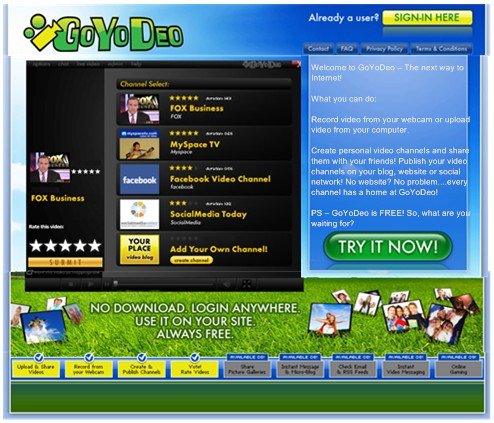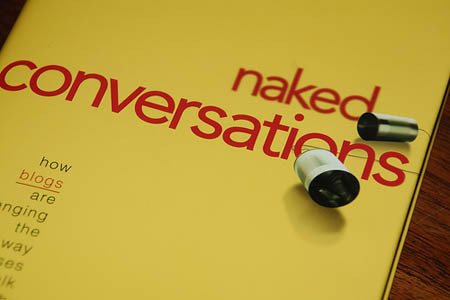Chapter 2
Is It We The Peoples?
The construct of our virtual community has
people learning to unite around common
causes—topics and the conversations abound.
History has shown a pattern of power shifts
fueled by conversations united, focused and
pointed at specific desires for change voiced by the collective peoples.
Today the web is enabling a stronger unification of voices whose influence is reaching epic proportions. Whether the voices speak to global issues of concern, corporate behavior or reactions to the news of the day, threads of conversations by the people stream without boundaries and build momentum in influence.
There are numerous examples of this dynamic happening even with today’s technological constraints. For example:
1. Community formation centric to issues, corporations and causes are exploding across all “networks.”
2. Participation by people in these communities is creating loud voices of influence being heard and reported by traditional media.
3. Demand for change centric to the issues of the peoples concern, desire and expectations is creating reactions by those affected by the peoples’ demand.
4. Reactions by the markets, the corporations and institutions ignite conversations in support of or against the reactions.
5. Organization of these new dynamics and how to manage them effectively is fueling the need for new methods of adaptation by markets, media, organizations, institutions and individuals.
6. Managing the outcomes of these dynamics is and will continue to become the factors of success or failure of the participants.
7. A method used to manage the outcomes is becoming a new management process aimed at collaborative win-win solutions that the collective people desire called Socialutions.
Just maybe the web of people can help bridge the historical cap between them, the organizations, and us, the people. After all, an organization is nothing more than a collection of people with a common purpose. How the people and related solutions are managed and the methods employed create the difference between success and failure. An organization without people is an empty shell with no purpose.
Tomorrow’s successful organizations will be driven by a new method and philosophy based on “We the Peoples are all aimed at Socialutions” that creates perpetual value for markets of other people, our shareholders, suppliers and customers—the people. We are not talking about socialization rather Socialutions. There is a difference--it is about united relations aimed at common purposes -- yours, mine and ours. You will get it if you understand the methods.
How Fast Is Web Time?
When you do a search for the words “Web Time” very little comes up to define the term, elements, or dynamics. Time has become a major factor in the lives of people. There never seems to be enough of it, people demand it, and most people want more of it.
In our nanosecond, hyperspeed world of instant communications and expectations of instant answers, we get frustrated when “people and processes” steal our time. We want answers, solutions and actions now!
When we do not get instant answers, immediate solutions to our problems, or responses to our inquiries it creates a negative, frustrating emotion. The whole dynamic of “customer service” is driven by the time factor, and the
“answer me now or I’ll be frustrated and disappointed” position of the inquirer. Just look at the blogosphere and consider what people are complaining about, such as: they took too much time, they couldn’t resolve my problem, and they put me on hold. I had to go through ten voice response steps to get to a live person and even then they transferred me to another person and I was on hold yet again.
The more time a supplier steals from their customers, the less time customers have to get things done! As the major brands wander into the social web, the first thing they need to do is ensure that they can operate in web time, and that is RIGHT NOW, not later!
Customers are used to real time communications and if your customer support system is not designed for real time responses, then you are damaging and hurting your brand and your reputation and hurting your customers.
How Important is Web Time?
MediaPost Research Brief notes: “Among the initial findings of a new study,
“Exploring the Link Between Customer Care and Brand Reputation in the Age of Social Media,” by the Society for New Communications Research, “… there is a growing group of highly desirable consumers using social media to research companies: 25- to 55-years old, college-educated, earning $100,000+…” said Dr. Ganim Nora Barnes, senior fellow, SNCR.”
“As social media usage becomes more ubiquitous, says the summary report, affluent consumers are using social media channels to share their personal customer service experiences and learn about others’ care experiences when making purchase decisions.”
Top findings include:
59.1% of respondents use social media to “vent” about a customer care experience.
72.2% of respondents research companies’ customer care online prior to purchasing at least sometimes.
84% of respondents consider the quality of customer care at least sometimes in their decision to do business with a company.
74% choose companies/brands based on others’ customer care experiences shared online.
81% believe that blogs, online rating systems and discussion forums can give consumers a greater voice regarding customer care.
Less than 33% believe that businesses take customers’ opinions seriously.
Search engines are considered to be the most valuable online tools for this research.
No matter what the brand is or what product or service it represents , the
time factor distinguishes the winners from the losers. All brands promise customer care but only a few are doing it in web time. Just try going to any ISP’s or wireless carriers web page. What is your immediate impression? Is the Web Site a waste of time because you cannot find the information or help that you need? These sites are not very social to say the least. If you are not good at responding, if you waste peoples’ time and create frustrations, those people will take the time to tell everyone about their experiences, one-to-one to millions at the click of a mouse.
In addition to saving the customer time, brands will also need to create social solutions that actually give the customers more discretionary time.
Impossible? Well maybe you are not looking in the right places because the possibilities are endless and they are called Socialutions. If you do not understand it, either your competition or your customers (which may be the same) will and your market will shift at the click of a mouse.

Is Time the Driving Factor?
With so many demands vying for our time and
attention, sometimes even a simple,
uninterrupted phone call seems to be a stretch of the imagination. Cell phones, personal digital assistants (PDAs), instant messaging, pagers, faxes, emails, and the list goes on, all contribute to information availability and overload.
In Western society, we have been trained to
“want what we want, when we want it - five
minutes ago.” Microwave ovens, cell phones,
instant potatoes, lightning-speed internet
searches, 24-7 news channels, all have
conditioned us to get things done faster. We are all chasing time as a value that drives us to either save or gain more of it.
Our attention is really the driver of the use of time. Time and attention are the factors to getting massive personal and professional leverage; by capturing the attention of someone, you are more likely to get others’ time and attention. Learning how to leverage time is the means of getting more peoples’ attention while saving your own time.
The web is becoming the means which enables massive personal and professional leverage, because you can reach the masses or swarms rather than reach a few. Those who can accomplish the greatest mass of personal and professional leverage will be those who gain the most use of their own time. Those who adopt, or more appropriately, transform their thinking, and learn how to use the web effectively and efficiently, will perpetuate value faster than ever before. The dynamics we are all facing becomes the Paradox of Choice, or where should we spend ou r most valuable asset – time?
Is the Web a Time Transport Mechanism?
In transport economics, the value of time is the opportunity cost of the time that travelers spend on their journey. In essence, this makes it the amount that travelers would be willing to pay in order to save time, or the amount they would accept as compensation for lost time. Is not the web anything more than a highway of transportation?
One of the main justifications for improvements to the web is the amount of time that people and businesses will save. Using a set of values of time, the economic benefits of any improvement can be quantified in order to compare them to the costs (thus forming the basis of cost-benefit analysis).
The value of time varies considerably from person to person and depends upon the purpose of web usage, but it can generally be divided into two sets of valuations: working time and non-working time. This division is appropriate because the value of working time (i.e. time spent on the web in the course of work) is calculated differently from the value of non-working time (i.e. time spent on the web outside work).
Where are People Spending Their Time Today?
People are spending twice as much time online as they are watching TV, a new study of consumer behavior by analyst firm IDC has found.
Silicon Republic reported, “The study found that the average amount of time spent online is 32.7 hours per week, compared with 16.4 hours spent watching TV.”
“The time spent using the internet will continue to increase at the expense of television and, to a lesser extent, print media,” said Karsten Weide, programme director, digital media and entertainment at IDC.
When Will the Web Give Back Time?
People have little patience with poor performance. While we are experiencing emerging web developments daily, much of it is a distraction and robs us of time. However, when we consider the converging activities in today’s marketplace and initiatives such as Vendor Relationship Management (VRM), it will not be long before the web will become the utility of choice for enhanced personal and professional productivity gains. Then the attraction will magnify and draw masses faster than ever before, and we will experience the dawning of The Relationship Economy fueled by Socialutions never before anticipated or experienced.
The time factors will become the market factors, and those who understand
“how to” will gain back time. Commerce will accelerate and new markets for businesses prepared will pull and attract consumers from old markets.
Everything in My Place – A Time Saving Application As we watch developments across the web, we look ahead as to where and when the functions and features will converge. Candidates include features such as video, micro blogging, networking, blogging, feeds, search etc.; functions such as user centric controls for all web activities and interfaces; and finally, yet importantly, how users and brands can monetize all these activities with user centric controls and ease of use.

Mary Meeker of Morgan Stanley states, “Moving on to video and then wrapping it up with monetized. This is the data of Cash Logic that I shared a little bit earlier. Peer-to-Peer file sharing traffic was 66 percent of Internet traffic in 2004. Video was the major portion of that at about 60 percent. The momentums for online video has continued to build these two next slides are eye sore with intent. In October of 2005 when the crew at Disney associated with Apple for the download of Lost and Desperate Housewives that was a bit of an eureka’ moment for the online video industry as the other major players realizing they needed to figure out an Internet strategy. This is the 27 events that have happened last year kind of culminating with Google’s acquisition of YouTube.”
“Online video has been out there, it has been largely available on peer-to-peer sites and increasingly it’s becoming tagged, findable and easy to search.
If we look at usage of video specifically, we believe that, this is again comScore data, that minutes’ growth on the Internet it continues to outpace page view growth. We think a lot of that has to do with usage of video.”
“Last point almost, 10 years ago if we had asked everyone in this room, a lot of very smart people, who would be the top 15 Internet retailers in 2005 we wouldn’t have this list. We might have voted Amazon at the top of the list.
We wouldn’t have had Newegg at number 10. We wouldn’t have had a group of offline retailers dominating the other 13 spots. Our question for the media companies is “Why shouldn’t the media companies be in the same spot for the mother load of video if they have the opportunity of monetize it?”
”Google and Yahoo account for about 60 percent of US online advertising revenue, per IB data. In turn, they share 30 percent of that with their partners and affiliates. That’s a lot of money shared with a lot of other players. Eric talked about yesterday on his Google presentation we think the opportunity is there is on the video side.” How About an All in One Application that Floats?
GoYoDeo, a division of The
Floating Apps Company,
launched a “floating web”
application. The application
enables users to create and
distribute video by channel,
publish personal photo
content, micro-blog, rate,
network and search all within
one application. The
application floats wherever you
go on the web. The application
is viral in that your friends can
follow your broadcast and

other web activity right on your app or interface you into their own app.
Now given the users’ threshold of pain relative to today’s web, GoYoDeo is attempting to resolve those pains while continuing to add functions and features that users want. Just maybe GoYoDeo has moved the game to the next level.
Are You a Billboard?
People work the web for
multiple purposes. Each
individual tries to gather
attention, friends, and entire
communities around their
messages. The web in turn
continues to feed us new
tools in which to connect,
communicate and spread our
messages. Contained in
these messages is new
information, different
perspectives and conversations about brands, markets and people.
The web presents a new “system” that is ever evolving and creating new dynamics and new rules to old games. The irony of the evolving “system” of the web is that it is largely influenced by the preferences and privileges of people creating new markets. The new markets are creating new rules to old games. The new rules are people centric and value driven. The Socialutions of the day lie not within the system of technology, rather of “people and values.”
What Are The People Values?
Seth Godin writes: “The web is nothing but a system, a bunch of (largely unwritten) rules regarding search, linking, promotion, etc. It’s fascinating to watch as some people work hard to work the system, and succeed time and time again, while others waste countless hours with one scheme after another designed to beat the system. They invent cloaking devices and seo scams and pyramid schemes and lightly disguised spam pages, constantly struggling to stay ahead (and to stay quiet). Sure, you can beat the system (any system) for a while, but it’s a constant struggle.”
“In Ultimate Frisbee, there are no referees. The system insists that you make your own calls… players closest to the play call it, with no real appeals. The goal: play in the spirit of the game. If you keep working to beat the system, you’ll end up with no one to play with. Work the system, and you’ll win now and later.”

A “system” that encourages you to make your own calls runs on unspoken rules that dictate human behavior. Unspoken rules operate on a value system that enhances relations and runs on “community trust.” If you do not know these unspoken rules, then you are likely to stand out like a “Billboard on Wall Street.” Just know that the new “system” is not friendly to Billboards.
Who Are the Social Mavericks?
A Maverick is a
person with
independence of
thought or action, a
non-conformist. As a
verb, it means to
seize something
without holding a
lawful claim to it.
The web enables
millions of people to
express independent
thought about
anything, everything
or anyone. However,
some express
thoughts that gain momentum with millions attaching themselves to a thought, which then becomes a movement against a brand, a process or a methodology.
Consider the Conversational Impacts:
A Maverick can start a conversation about a brand’s actions, attitudes or policies that seem anti-social and the masses follow.
A Maverick can start a conversation about the stupidity of a process that is anti-social and the masses follow.
A Maverick can start a conversation about a ridiculous method, which appears to be anti-social, and the masses follow.
The key word that describes a Virtual Maverick is “non-conformist.” They look at institutional processes, methods and policies and reject them as nothing more than a control mechanism. A Virtual Maverick attracts followers who agree with a position or perspective, and these followers spread the message, one-to-one to millions.
The momentum of the subsequent conversations builds and creates “pain” for individuals, businesses and entire institutions who feel threatened by the potential of a “social movement” that no longer wants or is willing to conform to the ways of the past. The threat of losing “control” creates a threat to the
“conformist” system that for years has created their economic gains, and is a threat to the economic foundation of traditional actions, systems, policies or methods.
Who are today’s Virtual Mavericks?
Today’s Virtual Mavericks are the thought leaders who forge ahead boldly and dare to state their non-conforming thoughts publicly. Their public statements create followers and those threatened watch closely to see if the conversations build momentum.
If we really want to stir up controversy, maybe we should consider starting
“The Virtual Mavericks” broadcast and make it viral. Each week we, the people, could vote on the quality and relativity of a Maverick’s thoughts then let the followers grow exponentially. These Social Mavericks would then be enabled to gather more followers and more power to actually create needed changes required to usher in The Relationship Economy.
Could this be a Socialution?
References
Godin, Seth. (2008, May 25). The Spirit of the Game Blog. Retrieved May 27, 2008, from http://sethgodin.typepad.com/seths_blog/2008/05/the-spirit-of-t.html
Billboard Image. Retrieved May 27, 2008, from http://www.londoninformation.org.uk/billboard_night_415x277.jpg MediaPost Publications. (2008). Retrieved May 6, 2008, from http://www.mediapost.com/publications
Meeker, Mary. (2007, January 17). Web 2.0 Podcast: The State of the Internet, Part 3. Retrieved May 8, 2008, from http://www.oreillynet.com/pub/a/network/2007/01/17/web-20-meeker.html Silicon Republic. (2008, February 19). Twice as much time spent on web as on TV 19.02.2008. Retrieved May 11, 2008, from http://www.siliconrepublic.com/news/news.nv?storyid=single10312
Weide, Karsten. (2008, February 19). IDC Finds Online Consumers Spend Almost Twice as Much Time Using the Internet as Watching TV. Retrieved May 11, 2008, from
http://www.idc.com/getdoc.jsp?containerId=prUS21096308









